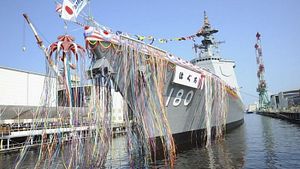Japanese shipbuilder Japan Marine United (JMU) Corporation launched the second of two improved Atago-class (aka Maya-class, 27DD- or 27DDG-class) guided missile destroyers on order for the Japan Maritime Self-Defense Force (JMSDF) at its facility in Yokohama on July 17, JMU said in a statement.
The 8,200-ton Maya-class destroyer, christened Haguru (PN 179), will be the eighth JMSDF surface combatant fitted with the Aegis combat system. In detail, the destroyer will receive the Aegis Baseline J7 combat system and the Northrop Grumman AN/SPQ-9B radar system capable of detecting and tracking low-flying, supersonic, low observable anti-ship missiles. The Aegis Baseline J7 combat system is the Japanese equivalent to the U.S. Navy’s Baseline 9/BMD 5.1 standard Aegis combat system. As I explained in July 2018:
The Aegis Baseline 9/BMD 5.1, jointly funded by the U.S. and Japanese governments, has been specifically designed for ballistic missile defense and can engage in simultaneous air and ballistic missile defense. The U.S. Naval Sea Systems Command awarded Lockheed Martin a $135.8 million contract for work on the development and integration of the Aegis Baseline 9 systems for the improved Atago-class of guided missile destroyers in December 2017.
The improved Atago-class destroyers will be armed with the SM-3 Block IIA, which has been under joint development by U.S. defense contractor Raytheon and Japan’s Mitsubishi Heavy Industries since 2006. The missile is designed to intercept incoming short- to intermediate-range ballistic missile targets in midcourse. The improved Atago-class will also receive Standard Missile-6 (SM-6) interceptors.
Other weapons systems include RIM-66 Standard Missile-2(SM-2) surface-to-air missiles and the RIM-162 Evolved Sea Sparrow Missile (ESSM) launched from the Maya’s 96 Mk 41 vertical launch system cells. The ship is also equipped with a multifunction towed array (MFTA) sonar systems and electronic warfare (EW) capabilities. It is powered by an improved combined diesel-electric and gas, or CODLAG, propulsion system.
To facilitate data-sharing with U.S. surface combatants, the Maya-class will also be fitted with a cooperative engagement capability (CEC), “a new wide-area integrated air defense system, which permits the real-time sharing of sensor data on air targets, including incoming enemy aircraft and cruise missiles, among CEC-equipped ships,” as I explained previously.
The first-of-class Maya (PN 179) was launched in July 2018 and is expected to be commissioned in March 2020. The warship recently completed its second round of sea trials. Each guided-missile destroyer cost about $1.6 billion to build. The Maya-class is named after Mount Maya in the Rokko mountain range in Kobe, Hyogo Prefecture on Honshu island.






























